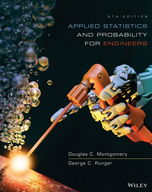Solution Found!
An article in the British Medical Journal [“Comparison of
Chapter 2, Problem 131E(choose chapter or problem)
Problem 131E
An article in the British Medical Journal [“Comparison of treatment of renal calculi by operative surgery, percutaneous nephrolithotomy, and extracorporeal shock wave lithotripsy” (1986, Vol. 82, pp. 879–892)] provided the following discussion of success rates in kidney stone removals. Open surgery had a success rate of 78% (273/350) and a newer method, percutaneous nephrolithotomy (PN), had a success rate of 83% (289/350). This newer method looked better, but the results changed when stone diameter was considered. For stones with diameters less than 2 centimeters, 93% (81/87) of cases of open surgery were successful compared with only 83% (234/270) of cases of PN. For stones greater than or equal to 2 centimeters, the success rates were 73% (192/263) and 69% (55/80) for open surgery and PN, respectively. Open surgery is better for both stone sizes, but less successful in total. In 1951, E. H. Simpson pointed out this apparent contradiction (known as Simpson’s paradox), and the hazard still persists today. Explain how open surgery can be better for both stone sizes but worse in total.
Questions & Answers
QUESTION:
Problem 131E
An article in the British Medical Journal [“Comparison of treatment of renal calculi by operative surgery, percutaneous nephrolithotomy, and extracorporeal shock wave lithotripsy” (1986, Vol. 82, pp. 879–892)] provided the following discussion of success rates in kidney stone removals. Open surgery had a success rate of 78% (273/350) and a newer method, percutaneous nephrolithotomy (PN), had a success rate of 83% (289/350). This newer method looked better, but the results changed when stone diameter was considered. For stones with diameters less than 2 centimeters, 93% (81/87) of cases of open surgery were successful compared with only 83% (234/270) of cases of PN. For stones greater than or equal to 2 centimeters, the success rates were 73% (192/263) and 69% (55/80) for open surgery and PN, respectively. Open surgery is better for both stone sizes, but less successful in total. In 1951, E. H. Simpson pointed out this apparent contradiction (known as Simpson’s paradox), and the hazard still persists today. Explain how open surgery can be better for both stone sizes but worse in total.
ANSWER:
Solution :
Step 1 of 1:
From the given information the success rate in kidney stone removals table is given below.
The the total open surgery had success rate is
Type |
Percent |
Fraction |
Open surgery |
78% |
|
PN |
83% |
Then stone diameter is less than 2 centimeters.
The table is given below.
Type |
Percent |
Fraction |
Open surgery |
93% |
|
PN |
83% |
Our goal is:
We need to explain how open surgery can be better for both stone sizes but worse in total.
Now the stone diameter is greater or equals to 2 centimeters.
Then the table is given below.
Type |
Percent |
Fraction |
Open surgery |
